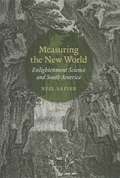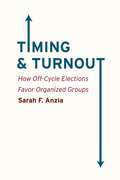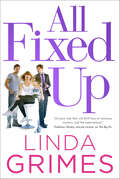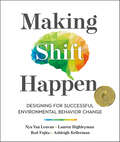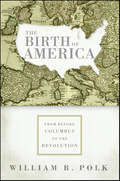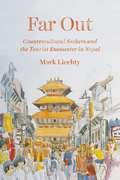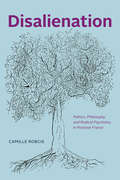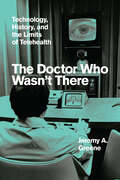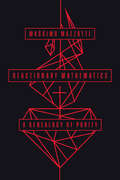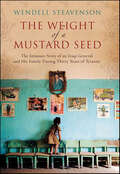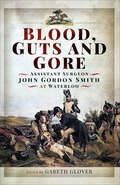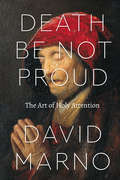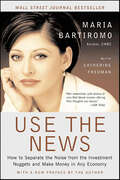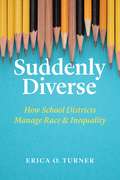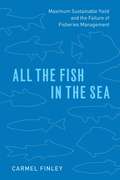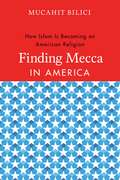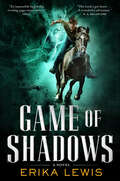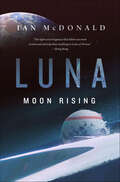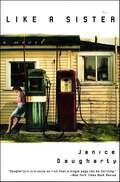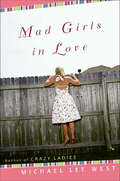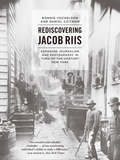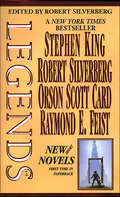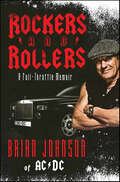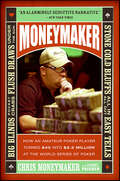- Table View
- List View
Measuring the New World: Enlightenment Science and South America
by Neil SafierPrior to 1735, South America was terra incognita to many Europeans. But that year, the Paris Academy of Sciences sent a mission to the Spanish American province of Quito (in present-day Ecuador) to study the curvature of the earth at the Equator. Equipped with quadrants and telescopes, the mission’s participants referred to the transfer of scientific knowledge from Europe to the Andes as a “sacred fire” passing mysteriously through European astronomical instruments to observers in South America.By taking an innovative interdisciplinary look at the traces of this expedition, Measuring the New World examines the transatlantic flow of knowledge from West to East. Through ephemeral monuments and geographical maps, this book explores how the social and cultural worlds of South America contributed to the production of European scientific knowledge during the Enlightenment. Neil Safier uses the notebooks of traveling philosophers, as well as specimens from the expedition, to place this particular scientific endeavor in the larger context of early modern print culture and the emerging intellectual category of scientist as author.
Panzer III German Army Light Tank: North Africa El Alamein to Tunis, 1941–1943 (Tankcraft Ser. #40)
by Dennis OliverThe Pzkpfw III tank was the mainstay of the Panzer divisions during the Blitzkrieg era and made up the bulk of the armored force sent to North Africa. Although less heavily armored than many of its opponents it was sturdy and reliable and its main armament was the equal of any enemy weapon it was called upon to face. Operating in one of the most inhospitable environments on earth the Pzkpfw III was at the forefront of the dramatic advances of 1941 and the defensive efforts of the following year, all undertaken in the incredible vastness of the Libyan desert. This volume of the TankCraft series concludes the story of the tank’s North African service, examining the models that took part in the campaign beginning with the retreat from El Alamein and ending with the surrender of the last Axis forces in Tunisia in May 1943. Using archive photos and extensively researched color illustrations to examine the Pzkpfw III and the units that operated this deservedly famous armored vehicle during the final battles in North Africa. A key section of his book displays available model kits and aftermarket products, complemented by a gallery of beautifully constructed and painted models in various scales. Technical details as well as modifications introduced during production and in the field are also examined, providing everything the modeller needs to recreate an accurate representation of these historic tanks.
Timing & Turnout: How Off-Cycle Elections Favor Organized Groups
by Sarah F. AnziaPublic policy in the United States is the product of decisions made by more than 500,000 elected officials, and the vast majority of those officials are elected on days other than Election Day. And because far fewer voters turn out for off-cycle elections, that means the majority of officials in America are elected by a politically motivated minority of Americans. Sarah F. Anzia is the first to systemically address the effects of election timing on political outcomes, and her findings are eye-opening. The low turnout for off-cycle elections, Anzia argues, increases the influence of organized interest groups like teachers’ unions and municipal workers. While such groups tend to vote at high rates regardless of when the election is held, the low turnout in off-cycle years enhances the effectiveness of their mobilization efforts and makes them a proportionately larger bloc. Throughout American history, the issue of election timing has been a contentious one. Anzia’s book traces efforts by interest groups and political parties to change the timing of elections to their advantage, resulting in the electoral structures we have today. Ultimately, what might seem at first glance to be mundane matters of scheduling are better understood as tactics designed to distribute political power, determining who has an advantage in the electoral process and who will control government at the municipal, county, and state levels.
All Fixed Up: A Novel (Ciel Halligan #4)
by Linda GrimesA shapeshifting young woman is caught posing as an astronaut—and caught in a deadly conspiracy—in the fourth entry in this urban fantasy series.Ciel Halligan, aura adaptor extraordinaire, has a lot of experience filling in for her clients—as them. A rare genetic quirk gives her the ability to absorb human energy and project it back out in a flawless imitation. She’s hard at work, posing as a well-known and celebrated astronaut, about to make a stunning announcement on behalf of the space program . . . when the photographer documenting the job sees right through her aura. Worse, it soon becomes apparent that he not only knows Ciel’s not who she’s supposed to be, but he also means her harm.When Ciel’s elderly Aunt Helen—also an aura adaptor—is murdered in Central Park, and the same photographer shows up at the funeral, Ciel starts to feel even more exposed. Then more adaptors are killed in the same way, and she becomes terrified her friends and family are being systematically exterminated . . . and it’s starting to look like she’s the ultimate target. She turns to Billy Doyle, her best-friend-turned-boyfriend, for help, but when an unexpected crisis causes him to take off without a word, she’s left to rely on her not-so-former crush, CIA agent Mark Fielding . . .Staying alive, keeping control of her romantic life, and unraveling the mystery of why adaptors are being pursued becomes a harder balancing act than ever in this Ciel Halligan adventure from Linda Grimes.Praise for All Fixed Up“Grimes keeps the pot bubbling with humor, suspense, steamy sex, riddles, danger . . . oh, and more hot sex. Sure to please series regulars and fans of urban fantasy/mystery/romance.” —Kirkus Reviews
Making Shift Happen: Designing for Successful Environmental Behavior Change
by Nya Van Leuvan Lauren Highleyman Rod Fujita Ashleigh KellermanNautilus Book Award Winner: An “engagingly written” behavioral science-based guide to tackling our urgent environmental problems (Robert B. Cialdini, author of Influence: The Psychology of Persuasion).To create a sustainable future and achieve positive, durable change, we must design solutions based directly on how people think, make decisions, and act. From hotels that save water (and money) using simple signage to energy suppliers that boost participation in renewable energy programs through mere enrollment-form tweaks, it’s clear that shifting the behavior of millions for the better is possible.Based on decades of research into what drives behavior change, Making Shift Happen provides a suite of powerful tools to transform the world. It features A-to-Z guidance on how to design a behavior change initiative—from choosing the right audience and uncovering what drives their behavior to designing, prototyping, testing, and implementation. Clear instructions and real-world examples empower you to apply hundreds of behavioral science solutions including:Using social norms to spread positive environmental behaviorsSelecting and testing stories, metaphors, and values to frame information for each audienceCatalyzing action by aligning your initiative with your audience’s personal and social motivatorsBreaking bad habits and building positive onesCapturing your audience’s attention and reducing barriers to actionConnecting people with nature and building empathy for the environment and its inhabitantsMaking Shift Happen is a must-have guide for practitioners in non-profits, governments, and businesses looking to design successful campaigns and initiatives that shift behaviors and mindsets toward positive environmental outcomes and a better future for all.“Completely fascinating—we’ve learned a lot about the ways minds work in the last decades and that may help us figure out how to appeal to our better angels more effectively than in the past. Rest assured that people who want to sell us junk are paying attention to these insights—the rest of us better do so too!” —Bill McKibben, author of The End of Nature
The Birth of America: From Before Columbus to the Revolution
by William R. PolkIn this provocative account of colonial America, William R. Polk explores the key events, individuals, and themes of this critical period. With vivid descriptions of the societies that people from Europe came from and with an emphasis on what they believed they were going to, Polk introduces the native Indians encountered in the New World and the black Africans who were brought across the Atlantic. With insightful analysis, he also discusses the dual truths of colonial societies' "growing up" and "growing apart." As John Adams would point out to Thomas Jefferson, the long years that witnessed the formation of our national character and the growth of our spirit of independence were indeed the real revolution. That story forms the basis of The Birth of America. In addition to its discussion of the influence the British had on the colonies, The Birth of America covers the pivotal roles played by the Spanish, French, and Dutch in early America.From the fearful crossing of the stormy Atlantic to the growth of the early settlements, to the French and Indian War and the unrest of the 1760s, William Polk brilliantly traces the progress of the colonies to the point where itwas no longer possible to recapture the past and the break with England was inevitable. America had been born.
Far Out: Countercultural Seekers and the Tourist Encounter in Nepal
by Mark LiechtyWesterners have long imagined the Himalayas as the world’s last untouched place and a repository of redemptive power and wisdom. Beatniks, hippie seekers, spiritual tourists, mountain climbers—diverse groups of people have traveled there over the years, searching for their own personal Shangri-La. In Far Out, Mark Liechty traces the Western fantasies that captured the imagination of tourists in the decades after World War II, asking how the idea of Nepal shaped the everyday cross-cultural interactions that it made possible. Emerging from centuries of political isolation but eager to engage the world, Nepalis struggled to make sense of the hordes of exotic, enthusiastic foreigners. They quickly embraced the phenomenon, however, and harnessed it to their own ends by building tourists’ fantasies into their national image and crafting Nepal as a premier tourist destination. Liechty describes three distinct phases: the postwar era, when the country provided a Raj-like throwback experience for rich Americans; Nepal’s emergence as an exotic outpost of hippie counterculture in the 1960s; and its rebranding into a hip adventure destination, which began in the 1970s and continues today. He shows how Western projections of Nepal as an isolated place inspired creative enterprises and, paradoxically, allowed locals to participate in the global economy. Based on twenty-five years of research, Far Out blends ethnographic analysis, a lifelong passion for Nepal, and a touch of humor to produce the first comprehensive history of what tourists looked for—and found—on the road to Kathmandu.
Disalienation: Politics, Philosophy, and Radical Psychiatry in Postwar France (Chicago Studies In Practices Of Meaning Ser.)
by Camille RobcisFrom 1940 to 1945, forty thousand patients died in French psychiatric hospitals. The Vichy regime’s “soft extermination” let patients die of cold, starvation, or lack of care. But in Saint-Alban-sur-Limagnole, a small village in central France, one psychiatric hospital attempted to resist. Hoarding food with the help of the local population, the staff not only worked to keep patients alive but began to rethink the practical and theoretical bases of psychiatric care. The movement that began at Saint-Alban came to be known as institutional psychotherapy and would go on to have a profound influence on postwar French thought. In Disalienation, Camille Robcis grapples with the historical, intellectual, and psychiatric meaning of the ethics articulated at Saint-Alban by exploring the movement’s key thinkers, including François Tosquelles, Frantz Fanon, Félix Guattari, and Michel Foucault. Anchored in the history of one hospital, Robcis's study draws on a wide geographic context—revolutionary Spain, occupied France, colonial Algeria, and beyond—and charts the movement's place within a broad political-economic landscape, from fascism to Stalinism to postwar capitalism.
The Doctor Who Wasn't There: Technology, History, and the Limits of Telehealth
by Jeremy A. GreeneThis gripping history shows how the electronic devices we use to access care influence the kind of care we receive.The Doctor Who Wasn’t There traces the long arc of enthusiasm for—and skepticism of—electronic media in health and medicine. Over the past century, a series of new technologies promised to democratize access to healthcare. From the humble telephone to the connected smartphone, from FM radio to wireless wearables, from cable television to the “electronic brains” of networked mainframe computers: each new platform has promised a radical reformation of the healthcare landscape. With equal attention to the history of technology, the history of medicine, and the politics and economies of American healthcare, physician and historian Jeremy A. Greene explores the role that electronic media play, for better and for worse, in the past, present, and future of our health. Today’s telehealth devices are far more sophisticated than the hook-and-ringer telephones of the 1920s, the radios that broadcasted health data in the 1940s, the closed-circuit televisions that enabled telemedicine in the 1950s, or the online systems that created electronic medical records in the 1960s. But the ethical, economic, and logistical concerns they raise are prefigured in the past, as are the gaps between what was promised and what was delivered. Each of these platforms also produced subtle transformations in health and healthcare that we have learned to forget, displaced by promises of ever newer forms of communication that took their place. Illuminating the social and technical contexts in which electronic medicine has been conceived and put into practice, Greene’s history shows the urgent stakes, then and now, for those who would seek in new media the means to build a more equitable future for American healthcare.
Reactionary Mathematics: A Genealogy of Purity
by Massimo MazzottiA forgotten episode of mathematical resistance reveals the rise of modern mathematics and its cornerstone, mathematical purity, as political phenomena. The nineteenth century opened with a major shift in European mathematics, and in the Kingdom of Naples, this occurred earlier than elsewhere. Between 1790 and 1830 its leading scientific institutions rejected as untrustworthy the “very modern mathematics” of French analysis and in its place consolidated, legitimated, and put to work a different mathematical culture. The Neapolitan mathematical resistance was a complete reorientation of mathematical practice. Over the unrestricted manipulation and application of algebraic algorithms, Neapolitan mathematicians called for a return to Greek-style geometry and the preeminence of pure mathematics. For all their apparent backwardness, Massimo Mazzotti explains, they were arguing for what would become crucial features of modern mathematics: its voluntary restriction through a new kind of rigor and discipline, and the complete disconnection of mathematical truth from the empirical world—in other words, its purity. The Neapolitans, Mazzotti argues, were reacting to the widespread use of mathematical analysis in social and political arguments: theirs was a reactionary mathematics that aimed to technically refute the revolutionary mathematics of the Jacobins. During the Restoration, the expert groups in the service of the modern administrative state reaffirmed the role of pure mathematics as the foundation of a newly rigorous mathematics, which was now conceived as a neutral tool for modernization. What Mazzotti’s penetrating history shows us in vivid detail is that producing mathematical knowledge was equally about producing certain forms of social, political, and economic order.
The Weight of a Mustard Seed: The Intimate Story of an Iraqi General and His Family During Thirty Years of Tyranny
by Wendell Steavenson“A masterly and elegantly told story that weaves together the Iraqi past and present.” —New York Times Book Review“A first-class investigation…that tells the reader more about the tensions of living close to power in Saddam’s dictatorship.”—Washington PostThe Weight of a Mustard Seed is an unprecedented and intimate account of Iraqi life under Saddam Hussein’s brutal regime, revealed through the tragic story of one of the dictator’s loyal generals. Journalist Wendell Steavenson writes thrilling nonfiction with a novelist’s flair, offering a new perspective on life inside a totalitarian regime that is as moving, compelling, and dramatic as The Kite Runner and The Bookseller of Kabul.
Blood, Guts and Gore: Assistant Surgeon John Gordon Smith at Waterloo
by John Gordon SmithJohn Gordon Smith wrote one of the most vivid, honest and readable personal accounts of the Battle of Waterloo and the ensuing campaign, where he served as a surgeon in the12th Light Dragoons, but his classic narrative was only published in a limited edition in the 1830s and since then it has been virtually unknown. His warts-and-all depiction of the British army in Belgium and France and the fighting at Waterloo rivals many of the more famous and often reprinted military memoirs of the period. That is why Gareth Glover, one of the foremost experts on the battle and the archive sources relating to it, has sought to republish the narrative now, with a full introduction and explanatory notes. Smith’s account reads like a novel, in a chatty, easy-going style, but it often records deeply shocking scenes and behaviour so scandalous that he had to avoid naming names. As well as recalling, in graphic detail, his experience as a medic during the battle, he records the aftermath, the allied occupation of France. His writing, which describes the truly dreadful consequences of the fighting as only a surgeon would see them, also gives the reader a rare insight into his role and a memorable impression of the life in the army as a whole.
Death Be Not Proud: The Art of Holy Attention
by David MarnoThe seventeenth-century French philosopher Nicolas Malebranche thought that philosophy could learn a valuable lesson from prayer, which teaches us how to attend, wait, and be open for what might happen next. Death Be Not Proud explores the precedents of Malebranche’s advice by reading John Donne’s poetic prayers in the context of what David Marno calls the “art of holy attention.” If, in Malebranche’s view, attention is a hidden bond between religion and philosophy, devotional poetry is the area where this bond becomes visible. Marno shows that in works like “Death be not proud,” Donne’s most triumphant poem about the resurrection, the goal is to allow the poem’s speaker to experience a given doctrine as his own thought, as an idea occurring to him. But while the thought must feel like an unexpected event for the speaker, the poem itself is a careful preparation for it. And the key to this preparation is attention, the only state in which the speaker can perceive the doctrine as a cognitive gift. Along the way, Marno illuminates why attention is required in Christian devotion in the first place and uncovers a tradition of battling distraction that spans from ascetic thinkers and Church Fathers to Catholic spiritual exercises and Protestant prayer manuals.
Use the News: How to Separate the Noise from the Investment Nuggets and Make Money in Any Economy
by Maria Bartiromo Catherine FredmanExplaining the methods that have made her -- and her stock picks -- famous, Maria Bartiromo tells investors how to use hot information to make money in any market, raging bull or lumbering bear. Packed with sage advice from the most influential people on Wall Street, Use the News is an indispensable investment handbook that will disclose the Wall Street insiders' secrets and show you how to take control of your investments.
Suddenly Diverse: How School Districts Manage Race and Inequality
by Erica O. TurnerFor the past five years, American public schools have enrolled more students identified as Black, Latinx, American Indian, and Asian than white. At the same time, more than half of US school children now qualify for federally subsidized meals, a marker of poverty. The makeup of schools is rapidly changing, and many districts and school boards are at a loss as to how they can effectively and equitably handle these shifts.Suddenly Diverse is an ethnographic account of two school districts in the Midwest responding to rapidly changing demographics at their schools. It is based on observations and in-depth interviews with school board members and superintendents, as well as staff, community members, and other stakeholders in each district: one serving “Lakeside,” a predominately working class, conservative community and the other serving “Fairview,” a more affluent, liberal community. Erica O. Turner looks at district leaders’ adoption of business-inspired policy tools and the ultimate successes and failures of such responses. Turner’s findings demonstrate that, despite their intentions to promote “diversity” or eliminate “achievement gaps,” district leaders adopted policies and practices that ultimately perpetuated existing inequalities and advanced new forms of racism. While suggesting some ways forward, Suddenly Diverse shows that, without changes to these managerial policies and practices and larger transformations to the whole system, even district leaders’ best efforts will continue to undermine the promise of educational equity and the realization of more robust public schools.
All the Fish in the Sea: Maximum Sustainable Yield and the Failure of Fisheries Management
by Carmel FinleyBetween 1949 and 1955, the State Department pushed for an international fisheries policy grounded in maximum sustainable yield (MSY). The concept is based on a confidence that scientists can predict, theoretically, the largest catch that can be taken from a species’ stock over an indefinite period. And while it was modified in 1996 with passage of the Sustained Fisheries Act, MSY is still at the heart of modern American fisheries management. As fish populations continue to crash, however, it is clear that MSY is itself not sustainable. Indeed, the concept has been widely criticized by scientists for ignoring several key factors in fisheries management and has led to the devastating collapse of many fisheries. Carmel Finley reveals that the fallibility of MSY lies at its very inception—as a tool of government rather than science. The foundational doctrine of MSY emerged at a time when the US government was using science to promote and transfer Western knowledge and technology, and to ensure that American ships and planes would have free passage through the world’s seas and skies. Finley charts the history of US fisheries science using MSY as her focus, and in particular its application to halibut, tuna, and salmon fisheries. Fish populations the world over are threatened, and All the Fish in the Sea helps to sound warnings of the effect of any management policies divested from science itself.
Finding Mecca in America: How Islam Is Becoming an American Religion
by Mucahit BiliciThe events of 9/11 had a profound impact on American society, but they had an even more lasting effect on Muslims living in the United States. Once practically invisible, they suddenly found themselves overexposed. By describing how Islam in America began as a strange cultural object and is gradually sinking into familiarity, Finding Mecca in America illuminates the growing relationship between Islam and American culture as Muslims find a homeland in America. Rich in ethnographic detail, the book is an up-close account of how Islam takes its American shape. In this book, Mucahit Bilici traces American Muslims’ progress from outsiders to natives and from immigrants to citizens. Drawing on the philosophies of Simmel and Heidegger, Bilici develops a novel sociological approach and offers insights into the civil rights activities of Muslim Americans, their increasing efforts at interfaith dialogue, and the recent phenomenon of Muslim ethnic comedy. Theoretically sophisticated, Finding Mecca in America is both a portrait of American Islam and a groundbreaking study of what it means to feel at home.
Game of Shadows: A Novel
by Erika LewisA young man plagued by the ability to see ghosts races to save the mythological land of Tara from a terrible fate in this stunning debut from Erika Lewis. Thousands of years ago in Ireland, an ancient race fought a world-changing battle—and lost. Their land overrun, the Celtic gods and goddesses fled, while the mythical races and magical druids sailed to an uncharted continent, cloaked so mankind could never find it. This new homeland was named Tara. In modern day Los Angeles, Ethan Makkai struggles with an overprotective mother who never lets him out of her sight, and a terrifying secret: he can see ghosts. Desperate for a taste of freedom, he leaves his apartment by himself for the first time—only to find his life changed forever. After being attacked by dive-bombing birds, he races home to find the place trashed and his mother gone. With the help of a captain from Tara who has been secretly watching the Makkais for a long time, Ethan sets out to save his mother; a journey that leads him to the hidden lands, and straight into the arms of a vicious sorcerer who will stop at nothing until he controls Tara. With new-found allies including Christian, the cousin he never knew he had, and Lily, the sword-slinging healer who&’d rather fight than mend bones, Ethan travels an arduous road—dodging imprisonment, battling beasts he thought only existed in nightmares, and accepting help from the beings he&’s always sought to avoid: ghosts. This LA teen must garner strength from his gift and embrace his destiny if he&’s going to save his mother, the fearless girl he&’s fallen for, and all the people of Tara.
Luna: Moon Rising (Luna #3)
by Ian McDonaldA LOCUS AWARD FINALIST FOR SCIENCE FICTIONThe continuing saga of the Five Dragons, Ian McDonald's fast-paced, intricately plotted space opera pitched as Game of Thrones meets The Expanse A hundred years in the future, a war wages between the Five Dragons—five families that control the Moon&’s leading industrial companies. Each clan does everything in their power to claw their way to the top of the food chain—marriages of convenience, corporate espionage, kidnapping, and mass assassinations. Through ingenious political manipulation and sheer force of will, Lucas Cortas rises from the ashes of corporate defeat and seizes control of the Moon. The only person who can stop him is a brilliant lunar lawyer, his sister, Ariel. Witness the Dragons' final battle for absolute sovereignty in Ian McDonald's heart-stopping finale to the Luna trilogy.Luna 1. Luna: New Moon 2. Luna: Wolf Moon3. Luna: Moon Rising
Like A Sister: A Novel
by Janice DaughartyIt is 1956, and thirteeen-year-old Sister must raise her three siblings on her own, as her mother, Marnie, has a new boyfriend who isn't interested in kids. Taking charge of her life, Sister befriends a kindly neighbor named Willa, who appears to be everything a mother should be. But when a respected and powerful man in town notices that Sister is blossoming -- unsupervised -- into quite a young woman, trouble starts to brew. Willa soon steps in to intervene, and Sister thinks she may have found salvation. But within the pages of Like a Sister, things are never what they seem.Depicting a vulnerable, heartbreaking, and richly Southern world, Like a Sister allows readers to gaze through the eyes of a young whom they will not soon forget.
Mad Girls In Love: A Novel (Girls Raised In The South Ser.)
by Michael Lee WestMichael Lee West's indomitable G.R.I.T.S. (Girls Raised in the South) are back -- enduring rough times with all the grace and outrageous flair expected of true Southern heroines.Bitsy Wentworth -- fleeing yet another relationship nightmare in a “borrowed” red Corvette, with her baby daughter and a recently acquired “demon child” -- has an APB out on her for attempted murder (she broke her ex-husband's nose with a frozen slab of ribs that she purchased at the Piggly Wiggly). Her mama, Dorothy, is writing letters to First Ladies from inside the Central State Asylum, while Aunt Clancy Jane has completed her inevitable progression from hippie to local Crazy Cat Lady. Three generations of unforgettable Crystal Falls, Tennessee, women -- and the men they attract, enrage, and confound -- are courageously plowing through tumultuous lives of compound disaster . . . and hoping the chaos the next wrong step leads to won't be insurmountable.
Rediscovering Jacob Riis: Exposure Journalism and Photography in Turn-of-the-Century New York
by Bonnie Yochelson Daniel CzitromBefore publishing his pioneering book How the Other Half Lives—a photojournalistic investigation into the poverty of New York’s tenement houses, home to three quarters of the city’s population—Jacob Riis (1849-1914) spent his first years in the United States as an immigrant and itinerant laborer, barely surviving on his carpentry skills until he landed a job as a muckraking reporter. These early experiences provided Riis with an understanding of what it was like to be poor in the immigrant communities that populated New York’s slums, and it was this empathy that would shine through in his iconic photos. With Rediscovering Jacob Riis, art historian Bonnie Yochelson and historian Daniel Czitrom place Jacob Riis’s images in historical context even as they expose a clear sightline to the present. In the first half of their book, Czitrom explores Riis’s reporting and activism within the gritty specifics of Gilded Age New York: its new immigrants, its political machines, its fiercely competitive journalism, its evangelical reformers, and its labor movement. In delving into Riis’s intellectual education and the lasting impact of How the Other Half Lives, Czitrom shows that though Riis argued for charity, not sociopolitical justice, the empathy that drove his work continues to inspire urban reformers today. In the second half of the book, Yochelson describes for the first time Riis’s photographic practice: his initial reliance on amateur photographers to take the photographs he needed, his own use of the camera, and then his collecting of photographs by professionals, who by 1900 were documenting social reform efforts for government agencies and charities. She argues that while Riis is rightly considered a revolutionary in the history of photography, he was not a photographic artist. Instead, Riis was a writer and lecturer who first harnessed the power of photography to affect social change. As staggering inequality continues to be an urgent political topic, this book, illustrated with nearly seventy of Riis’s photographs, will serve as a stunning reminder of what has changed, and what has not.
Legends 1: Short Novels By The Masters Of Modern Fantasy (Legends #2)
by Stephen King Orson Scott CardAcclaimed writer and editor Robert Silverberg asked the masters of modern fantasy to write a new story based on one of his or her most famous series:Stephen King tells a tale of Roland, the Gunslinger, in the world of The Dark Tower, in "The Little Sisters of Eluria."Robert Silverberg returns to Majipoor and to Lord Valentine's adventure in an ancient tomb, in "The Seventh Shrine."Orson Scott Card spins a yarn of Alvin and his apprentice from the Tales of Alvin Maker, in "Grinning Man."Raymond E. Feist's Riftwar Saga is the setting of the tale of "The Wood Boy." And look for Legends 2 (featuring Terry Goodkind, George R.R. Martin, and Anne McCaffrey) and Legends 3 (featuring Robert Jordan, Ursula K. Le Guin, Tad Williams, Terry Pratchett)!
Rockers and Rollers: A Full-Throttle Memoir
by Brian Johnson“Surprisingly refreshing . . . You don’t need to know anything about AC/DC to appreciate his funny and highly descriptive writing about [cars].” —Publishers WeeklyFrom “Pink Cadillac” to “Low Rider” to “Little Red Corvette,” rock music has always had a racy love affair with cars. And AC/DC lead singer Brian Johnson is not only a rock legend, second-to-none at infusing razor-sharp lyrics with the screaming metal energy of a true rock and roller, but also a dyed-in-the-wool car fanatic. Books like AC/DC: Maximum Rock and Roll and Why AC/DC Matters revealed the secrets of the world’s greatest rock band—now, in Rockers and Rollers, fans will get a rare, riveting window into Brian Johnson’s other driving passion, his love for automobiles. From teenage memories in the backs of beat-up coups to a side career as a racecar driver, Johnson shares his tantalizing life story—a memoir told through his lifelong love affair with cars.“A fast, fun read . . . Johnson’s gifts for storytelling and humor shine.” —The New York Times
Moneymaker: How an Amateur Poker Player Turned $40 into $2.5 Million at the World Series of Poker
by Chris Moneymaker Daniel PaisnerIn 2004 the number of entrants -- and the winning pool -- at the World Series of Poker tripled, thanks in large part to Chris Moneymaker, an amateur player who came out of nowhere to win the 2003 Series, and prove to newcomers and poker pros alike that anything is possible with a chip and a chair.Moneymaker was a young accountant from Tennessee who loved to gamble but only took up cards after college. Three years later he was playing a $40 game of online Texas Hold 'Em and won a coveted seat at the 2003 World Series of Poker. Borrowing money to get to Las Vegas, he entered his first real-time tournament and spent the next four days battling for a top spot at the final table.Filled with everything from his early gambling ventures to a play-by-play of his major hands at the World Series of Poker, Moneymaker is a gripping, fast-paced story for anyone who has ever dreamed of winning it big.
